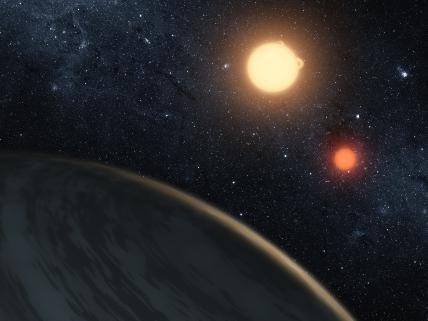Planet Orbiting Two Stars Evokes 'Star Wars'

Astronomers have discovered a planet whirling around not one but two stars, expanding the pantheon of known heavenly bodies to places formerly reserved for fictions like the twin-sunned Tatooine of Star Wars Fame.
NASA astronomers say that the planet, officially named Kepler 16b but already informally referred to as Tatooine, is the first confirmed instance of a planet orbiting two stars at once. Located about 200 light years from Earth, the planet orbits a red star and an orange star that are themselves circling each other, and has sparked amazement in the astronomy community.
The reality goes beyond the imagination of the most creative theorist in astronomy or science fiction writer, astrophysicist Fred Rasio at Northwestern University, who wasn't involved in the discovery, told The Wall Street Journal. Just about anything you could think of as a planetary system is actually out there.
'May The Force Be With You'
Acknowledging the Star Wars parallel, NASA invited John Knoll of Industrial Light and Magic, the special-effects company behind the Star Wars movies, to attend the announcement.
When I was a kid, I didn't think it was going to be possible to make discoveries like this, Knoll said.
Kepler 16b's discovery also upended assumptions about how far away a planet would need to be from two stars in order to remain stable. Scientists now believe that planets existing in so-called double binary systems could be more common than they had thought -- Laurance Doyle of the SETI Institute, who led the mission, said that the discovery removes all doubt that such systems can exist.
Scientists found Kepler 16b by keeping the Kepler telescope trained on a section of sky in the Cygnus and Lyra constellations and looking for regular changes in the light emanating from stars that occur when planets pass in front of them. If scientists observe regularly timed dips in the amount of light, they turn to software to decide whether the change is caused by a planet. With 16b, scientists determined that the particular pattern of the planet's fluctuating light could only come from a second sun.
We saw extra dips in the light curve, Doyle told msnbc.
Kepler 16b's interaction with two different suns means that temperatures on its surface can vary by about 50 degrees, between roughly minus 100 degrees Fahrenheit and minus 150 degrees Fahrenheit. One star is about two thirds of the mass of the sun, and the other is about one fifth.
© Copyright IBTimes 2024. All rights reserved.





















